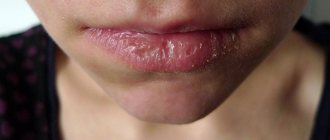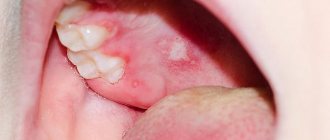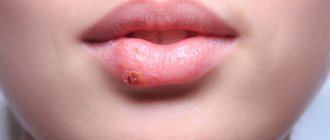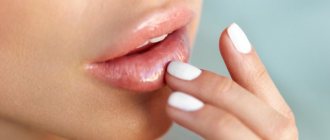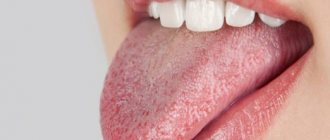From this article you will learn:
- the best pills and ointment for herpes on the lips,
- causes of herpetic rashes,
- how to quickly cure herpes on the lips in 1 day,
- treatment in children, vaccination (inoculation).
Herpes on the lips is a chronic, recurrent form of herpes, which is a consequence of infection with the herpes virus in early childhood. After a child has suffered a primary herpes infection, the herpes virus remains in the body for life (in an inactive state in the nerve ganglia). Under certain conditions, it is activated, causing the formation of herpetic eruptions - this occurs most often on the lips and skin around the mouth.
There is a whole family of herpeviruses, but herpes on the face and red border of the lips is caused only by the herpes simplex virus (types HSV-1 and HSV-2). Transmission of herpes infection occurs by contact and airborne droplets. The contact route involves spreading the virus through kissing, sharing cutlery, towels, etc. It is noteworthy that in 10% of adults, the herpes virus is constantly present in the saliva - even in the complete absence of clinical manifestations of herpes infection.
Herpes on the lips: photo
In the photo below you can see examples of mild herpes. In some cases, herpetic rashes can completely cover the entire surface of the lips, as well as the skin around the entire mouth. How to treat herpes on the lip will depend on the severity of the disease, for example, in mild cases, conventional external agents in the form of a cream (with acyclovir or penciclovir) are sufficient. And for severe lesions, tablets based on valacyclovir or famciclovir are usually prescribed.
What does herpes look like on the lips: photo
It is no coincidence that herpes occurs most often on the lips. After the initial illness, the herpes simplex virus persists for life in the sensory and autonomic nerve ganglia (clusters of nerve cells). This is precisely the reason why herpetic eruptions occur primarily where there are a large number of sensory nerve fibers. There are many of them on the lips, oral mucosa, as well as the cornea of the eye and external genitalia.
Rash due to thrush in women
Candidiasis or thrush is an infectious and inflammatory disease caused by the proliferation of fungi of the genus Candida. Pathology occurs in almost every woman, because Candida is part of the opportunistic flora of the genital tract. Decreased immunity allows microorganisms to actively multiply, which leads to the appearance of characteristic symptoms.
The main symptom of the development of thrush is a cheesy white discharge from the vagina. Then an unpleasant red rash appears on the skin and mucous membranes of the genital organs. The rashes often itch, which is very irritating and provokes scratching of the affected areas. The woman also feels a burning sensation, which intensifies during sexual intercourse and urination. Pimples on the genitals with thrush are always covered with a white coating. This is the main sign of the development of a fungal infection.
Herpes on the lips: causes
In this article we will talk in detail about the treatment of herpes on the lips and around the mouth - using external agents in the form of ointments, as well as tableted antiviral drugs. Below we will tell you which ointment for herpes on the lips is the most effective, as well as how to quickly get rid of herpes on the lips (in just a few days - sometimes even in 4 days), using our simple recommendations.
By the way, in addition to ointments and tablets for herpes on the lips, we will tell you about an excellent remedy for preventing repeated outbreaks of herpes (a vaccine called “Vitagerpavac”), which can significantly reduce the frequency of relapses of herpes. But before that, we would like to tell you in more detail about the reasons for repeated relapses of herpes infection, which is actually very important - if you plan to get herpes much less often.
1) Causes of primary herpetic infection -
When a child is born, his blood contains antibodies to the herpes virus, which were received from the mother during pregnancy. Clinical manifestations of herpes do not occur as long as the child maintains a sufficiently high titer of these antibodies (even despite the fact that the child may already be infected with the herpes virus). Gradually, the amount of maternal antibodies decreases, and usually between 6 months and 3 years, the child experiences the first outbreak of herpes.
How does infection occur?
Infection of a child in early childhood occurs through people who have contact with the child, as well as through the personal belongings of sick people. The most contagious are people whose herpes is at the stage of burst or unbroken blisters. But a child can become infected even from a person without any clinical manifestations of herpes, because About 10% of adults constantly have the herpes virus in their saliva.
Typically, infection occurs -
- through kisses,
- using the same dishes and utensils for eating,
- through the use of someone else's towel or personal belongings,
- through touching objects touched by a person with active clinical manifestations of herpes.
2) Causes of repeated outbreaks of herpes –
During initial contact with cells, the herpes virus penetrates deep into tissues, including nerve fibers. Spreading along the nerve fibers, the virus penetrates the nerve ganglia, where it will remain in an inactive dormant state throughout your life. Under the influence of unfavorable environmental factors, the virus will periodically be activated and cause clinical manifestations.
Causes of repeated outbreaks of herpes on the lips -
- contact with a person with clinical manifestations of herpes,
- weakened immunity (due to ARVI, taking steroids or chemotherapy),
- decrease in the level of lymphocytes in the blood,
- hypothermia,
- excessive exposure to the sun,
- dehydration,
- stress and severe physical fatigue,
- abrasions, cuts, scratches on the skin and red border of the lips,
- after a visit to the dentist (prolonged wide opening of the mouth leads to the appearance of cracks in the red border of the lips and in the corners of the mouth),
- cosmetic procedures,
- during menstruation in women.
Important: frequent relapses of herpes on the lips and skin around the mouth indicate a failure of the immune system. In addition, the herpes virus has its own damaging effect on the immune system, which further increases the severity and frequency of relapses. Therefore, below we will talk, including about the vaccine and immunostimulating drugs.
Causes of rashes in the intimate area
The content of the article
In women, rashes of various types most often appear on the pubis, genitals, and perineum. These can be ulcers, spots, pimples and other visually noticeable skin lesions. These manifestations may be associated with frequent shaving, mild allergies, and poor hygiene. However, quite often rashes in the intimate area require medical attention, as they become a response to infection.
The appearance of an unpleasant rash in the intimate area is associated with the following factors:
- Infection
. The nature of the rash depends on the type of infection that is actively multiplying in the body. Infection with a sexually transmitted infection is usually accompanied by additional symptoms. This may include purulent discharge, itching in the groin, and menstrual irregularities. - Weakening of the immune system
. This factor allows opportunistic flora to actively reproduce. Chronic diseases, antibiotic treatment, chemotherapy, childbearing, and hypothermia seriously weaken the immune system. - Chemical burn
. Aggressive substances destroy the upper layers of the epidermis. The body responds to this with the appearance of small, painful pimples. - Synthetic underwear
. Sometimes it causes genital allergies. Poor quality fabric does not allow the skin to “breathe”, which leads to the proliferation of pathogenic flora; - Ignoring hygiene rules
. This creates favorable conditions for viruses and bacteria to enter the body. It is especially important to carefully observe intimate hygiene during menstruation.
Herpes on the lip: symptoms
Now we will talk about a nuance that is very important for a quick cure. It lies in the fact that after activation of the virus, herpetic eruptions do not appear immediately. At the very beginning, you may feel that in some area of the lip or skin around the mouth there is itching, burning, redness or a feeling of tissue swelling (24stoma.ru). Such symptoms always precede the stage of active herpetic eruptions, and this period is called the prodromal period of the disease.
For different people, this period can last from several hours to 1-2 days. Many patients ask: if herpes occurs on the lip, how to treat it quickly - and the answer is that the most effective quick treatment is only possible when you start it during this prodromal period (i.e., even before the appearance of herpetic blisters). And below we will recommend you an ointment for herpes on the lips, the use of which during this period can sometimes prevent the appearance of rashes altogether.
Stages of active clinical manifestations –
At the very beginning of the development of the active phase of the disease, the patient notices that a slight swelling has appeared in the area of the red border of the lips (where there was itching and burning). This is due to the fact that during this period the herpes virus begins to actively divide, which ends with the formation of herpetic vesicles. The liquid inside the blisters is very contagious, and it is simply teeming with the herpes virus. That is why you should never squeeze out bubbles, because... this will lead to an increase in the affected area.
At first, the bubbles are filled with a clear liquid, but gradually it becomes cloudy. The opening of the bubbles occurs spontaneously, and usually this occurs 2-3 days after their formation. If you have not started treatment for herpes right away, then it is very important to start it before the herpetic vesicles open (i.e., up to 48 hours from the moment the herpetic rash appears). Otherwise, treatment will have virtually no effect on the speed of recovery.
Usually on day 3, all the tiny bubbles have already burst and, uniting, create one large “wet ulcer” (Fig. 7). By the way, during this period of opening of the vesicles, a slight increase in body temperature + enlargement of the submandibular lymph nodes may sometimes occur. At about 4-6 days, the surface of the ulceration becomes covered with crusts (Fig. 8-10). This stage is still contagious because Virus-rich liquid still oozes from cracks in the crusts.
After the inflammation subsides under the crusts, the red border of the lip gradually begins to recover (without treatment this occurs in the period from 7 to 12 days, with timely treatment - usually on days 5-7). Under no circumstances should the crusts be torn off, because... this can lead to both a new outbreak of herpes and a prolongation of the healing process (in place of the removed crusts, a wet ulcer will appear again, which will again be covered with a crust).
The total duration of a herpes outbreak on the lip until complete epithelization is on average 12-13 days (in the absence of timely treatment). However, when using classical remedies based on the slightly outdated acyclovir, the duration of the disease is reduced to 8.5 days, which is confirmed by clinical studies. But the best remedy for herpes on the lips, which we will discuss below, can reduce this period to 5-6 days, and sometimes even prevent the appearance of rashes.
Rash due to syphilitic infection in women
Syphilis is an infectious disease that is sexually transmitted. This is a dangerous and serious disease that affects the genital organs, liver, and nervous system. Without adequate medical care, a person becomes disabled or dies.
Sexual infection appears 1-2 months after infection. Its first sign is the formation of a dense, hard chancre on the labia or vaginal mucosa. This is the main symptom of the onset of the inflammatory process. After 4-6 weeks, the solid formation disappears. An imaginary feeling of recovery appears.
In fact, at this time the infection is already spreading throughout the body. This is evidenced by a small pink rash in the groin area in women, which appears after 5-10 days. The rash also affects the mucous membranes of the mouth and eyes. With syphilis, small dense condylomas also appear in the intimate area. They are located mainly on the labia and anus.
The rash with syphilis in women does not itch or hurt. The infection is accompanied by abnormal vaginal discharge. Leucorrhoea contains impurities of pus, becomes thicker, and has an unpleasant odor. Whitish papules, ulcers and purulent discharge are characteristic signs of the second stage of syphilis.
In the third stage, the characteristic rash spreads throughout the body. Sometimes the rash goes away, but after a couple of weeks the syphilitic rash in women again covers the entire body.
How to treat herpes on the lips -
If herpes occurs on the lip, treatment is carried out with antiviral drugs in the form of ointments, creams or tablets. You will get the fastest results from treatment either when you start treatment at the prodromal stage of the disease (i.e. when itching, burning and redness of the tissues are already present, but there are no herpetic blisters yet), or within the first 12 hours from the moment of appearance rashes. The duration of treatment is usually from 4 to 6 days, but for severe lesions - up to 10 days.
Please note that treatment will be at least somewhat effective only if it is started before 48 hours from the moment the rash appears. After this period and/or after the herpetic blisters have opened, the use of antiviral cream or tablets will no longer significantly affect the rate of healing. Below you will find a list of the best products for topical use (in the form of an ointment or cream), and we will also tell you which tablets for herpes on the lips can be used to cope with a herpes infection as quickly as possible.
The best ointment for herpes on the lips -
Herpes on the lips - treatment is traditionally carried out using an ointment or cream containing 5% Acyclovir. This component is very effective against the herpes simplex virus (types HSV-1 and HSV-2), and herpes virus resistance to acyclovir usually occurs in only 1-3% of patients. Let us draw your attention to the fact that acyclovir penetrates deep into tissues rather poorly, and in order to increase its penetration, some manufacturers add, for example, a component such as propylene glycol to the composition of the drugs.
The second point is that external agents with acyclovir can be in the form of “ointment” or “cream”. Always choose the latter option because... Compared to ointment, the penetration of active substances from a cream will always be higher. And another important selection criterion for women is that if the product contains dimethicone (silicone), then cosmetics can be applied on top of it. And now let's see how and with what to treat herpes on the lip, so that the effect appears quickly.
1) Zovirax Duo-Active Cream (UK) –
We consider this cream for herpes on the lips to be the best, and it is intended for adults and teenagers from 12 years of age. Zovirax Duo-Active cream contains not only 5% acyclovir, propylene glycol and dimethicone, but also 1% hydrocortisone (it effectively reduces inflammation, swelling and tissue tenderness). But the most important thing is that if the use of the cream begins even before the appearance of herpetic blisters, then hydrocortisone can sometimes even prevent their formation. But if bubbles do appear, their number and size will be significantly smaller.
Cream "Zovirax Duo-Active" -
If use begins after the rash appears, the presence of hydrocortisone will significantly reduce the healing time (compared to creams containing only acyclovir). Therefore, we believe that this is the best fast acting remedy for herpes on the lips. Clinical studies also showed that adding hydrocortisone to acyclovir helped reduce the incidence of new outbreaks of herpes labialis. However, this decrease was significant only in those patients whose immunity was not weakened.
Dosage regimen: apply a thin layer to herpetic rashes and adjacent skin 5 times a day (at intervals of about 4 hours), for 5 days. For Zovirax Duo-Active the price for a 2 g tube is about 350 rubles. This tube volume is enough for several cases of herpes on the lips.
Important: Zovirax Duo-Active cream will indeed have an excellent effect, but provided that your herpes virus is not resistant to acyclovir. Resistance can be assumed if, against the background of the latest outbreak of herpes, the use of acyclovir cream did not produce a noticeable result (although you started treatment on time). Most often, resistance to acyclovir develops in patients with a weakened immune system - subject to frequent use of courses of treatment with drugs containing acyclovir in the past. Resistance occurs in 10 to 27% of the patient groups described above. If we suspect the presence of resistance to acyclovir, it is better to choose Fenistil-Pencivir cream, or its tablet analogue - the drug Famciclovir.
Cream Fenistil-Pencivir (Switzerland) –
Fenistil-Pentsivir cream contains penciclovir 1%, which is a derivative of famciclovir, one of the most powerful antiviral drugs for herpes. Compared to acyclovir, penciclovir has a significantly greater tropism for the herpes virus, which means it finds it more easily in infected cells and kills it faster. The drug also contains propylene glycol and cetomacrogol to improve the penetration of penciclovir into virus-infected cells. The drug can be used from 12 years of age.
This drug has a number of important features. Firstly, there are practically no strains of the herpes virus resistant to penciclovir, and therefore it is effective even in the presence of resistance to acyclovir. Secondly, drugs with acyclovir are especially effective only when you start using them early (preferably no later than 12 hours after the appearance of the rash), and penciclovir does not lose effectiveness even at later stages. Those. if more than 12 hours have passed since the rash, or even more so more than 24 hours, it is better to purchase Fenistil-Pentivir.
Dosage regimen - the only disadvantage of the drug is the inconvenient application regimen, because the cream should be applied every 2 hours (8 times in total during the day). However, the drug usually needs to be used for only 4 days, because penciclovir has a long half-life from cells. Thanks to this, the antiviral effect of the cream lasts for up to 2 days from the end of its use. The price of Fenistil-Pentsivir per 2 g tube will be from 350 rubles. A version of the cream with a toning effect – from 430 rubles.
Editors' comments - thus, what is the best way to treat herpes on the lip - will depend on the initial data. If you start treating herpes at a very early stage, then it is definitely better to have Zovirax Duo-Active cream on hand (provided that you do not have resistance to acyclovir). Fenistil-Pentsivir cream will be effective in any case - both with early and even with later use. However, it will not prevent the formation of herpetic eruptions if you start using it in the prodromal period, and it does not have an anti-inflammatory effect. However, it is Fenistil-pencivir cream (or its tablet analogue Famciclovir) that is best used in patients with weakened immune systems.
Zovirax Cream (UK) –
This is the original drug of acyclovir in the form of 5% cream. Unlike Zovirax Duo-Active cream, regular Zovirax cream does not contain hydrocortisone, and therefore it can be used without age restrictions. Let us repeat that Zovirax contains exactly the original formula of acyclovir, which guarantees the high effectiveness of the drug (provided there is no resistance to acyclovir).
The drug also contains dimethicone, which allows you to apply cosmetics (for example, lipstick) after it dries, as well as propylene glycol, which facilitates the penetration of acyclovir into cells affected by the virus. The drug is used at least 5 times a day (at intervals of 4 hours, excluding sleep), but it is best to use it 8 times a day - at intervals of 2 hours. The duration of treatment is usually 5 days, but in case of severe damage it can be up to 10 days. The cost of Zovirax cream in pharmacies is from 190 rubles per 5 g tube.
More affordable drugs - let’s say right away that there are simply no alternatives to the drugs Fenistil-Pentsivir or Zovirax Duo-Active, which contain penciclovir or acyclovir in combination with hydrocortisone, in Russian pharmacies. But there is a large group of creams and ointments that contain only 5% acyclovir (in combination with propylene glycol and/or dimethicone).
The cheapest product is 5% Acyclovir Akrikhin ointment - about 40 rubles. But it should be noted that the ointment is much less absorbed than the cream, which impairs the penetration of acyclovir into tissues (even despite the presence of propylene glycol in the composition). Acyclovir-Belupo cream and Acyclovir-Hexal cream cost only about 70 rubles, and both drugs contain 5% acyclovir and propylene glycol. Acyclovir-Sandoz cream costs from 150 rubles, but it already contains dimethicone (which allows you to apply cosmetics on top of the dried cream).
Rash due to hormonal imbalance in women
Hormonal imbalance is dangerous for a woman’s health. Reproductive function, metabolism, hair, nails, and skin suffer from improper hormone production. Active acne that is difficult to treat is a clear sign of hormonal imbalance.
Hormonal rash in a woman manifests itself in the form of acne and pimples, characteristic of adolescence. The formation of acne is promoted by clogging of the sebaceous glands with dead epithelium. Moreover, in case of hormonal imbalance, sebum is produced more actively. This provokes the appearance of new acne. The clogged ducts begin to fester. Often, ulcers are accompanied by a secondary infection, which further complicates treatment.
Hormonal acne occurs throughout a woman's body. But more often acne is observed on the face, back, and back of the head. Sometimes acne appears in the pubic area in women. This happens due to blockage of the pubic hair follicles. Hormonal rash spreading to the intimate area requires a comprehensive diagnosis. Unlike adolescence, hormonal acne in an adult woman does not go away on its own. It is necessary to start treatment.
Herpes on the lips: treatment quickly in 1 day
To treat chronic recurrent herpes in adults, tablet antiviral drugs, for example, Valacyclovir or Famciclovir, can be used.
They can be used both as monotherapy and in combination with external agents. If treatment with Valaciclovir or Famciclovir is started no later than 12 hours from the moment the rash appears, the course of therapy is only 1 day (provided that the patient does not have a weakened immune system). Please note that all of these drugs are prescription drugs. Accordingly, their use is possible only as prescribed by a doctor, and only in patients over 12 years of age.
Valacyclovir (Valtrex) –
Clinical studies have shown that a short 1-day course of high-dose valacyclovir is even more effective than a long course of usual average dosages. The best results in the treatment of herpes on the lip were achieved when taking the drug 2000 mg twice a day (with an interval of 12 hours) - you only need to take the drug for 1 day. But such a one-day course of treatment is effective only under two conditions - 1) the drug is started no later than 12 hours from the moment the herpetic rash appears, 2) you must have normal, unimpaired immunity.
If more than 12 hours have passed and/or you have a weakened immune system, a standard course of therapy would be optimal. Standard treatment regimen: 500 mg 2 times a day (3 or 5 days in total - depending on the clinical picture). But in severe cases of herpes infection, taking the drug can be extended up to 10 days. The original drug of valacyclovir is Valtrex (UK), and the package is 10 tablets. 500 mg each will cost you about 1,250 rubles. There are also cheaper generics, but we recommend buying either the original Valtrex, the Bulgarian Valvir, or the Indian Vairova.
Important: valacyclovir is a chemical precursor to acyclovir, and therefore, if your herpes virus is resistant to acyclovir, you will also be resistant to valacyclovir. Therefore, in patients with immunodeficiency conditions (poor immune system), patients who have been treated frequently and for a long time with acyclovir in the past, it is best to use Famciclovir. The latter is one of the most effective antiviral agents against the herpes simplex virus.
Famciclovir (Favirox) –
Once in the body, famciclovir is metabolized into penciclovir. Thus, famciclovir is a tablet analogue of Fenistil-Pentsivir cream. If you started taking the drug earlier than 12 hours from the moment of the appearance of herpetic rashes, as well as in a normal state of immunity, a 1-day dosage regimen will be optimal (750 mg 2 times a day, with a 12-hour interval between doses).
If the patient has a weakened immune system, or if treatment is started later than 12 hours from the moment the herpetic rash appears, the standard dosage regimen should be used. According to the instructions, the standard regimen is 250 mg 2 times a day for 5 days (however, in severe cases of herpes infection, the dose can be extended to 7-10 days). Here I would like to add that numerous clinical studies have revealed the weak effectiveness of the standard regimen, especially in patients with a poor immune system.
Clinical studies have shown that the effectiveness of therapy increases significantly when famciclovir is prescribed in higher dosages. In patients with good immunity, a regimen of 500 mg 2 times a day (for 5 days) can be used. In patients with a weakened immune system - 500 mg 3 times a day (for 7 days).
Important: treatment with these drugs will be most effective if you start taking them - either in the prodromal period of the disease (when itching and tingling appear on the lip, but there are no herpetic blisters yet), or within the first 12 hours from the moment the herpetic rash appears. If these drugs are used at a later date (up to 48 or even more so 72 hours), then their effectiveness will be significantly lower. An important point is that the later you start taking the drug, the more preferable it is to take famciclovir before valacyclovir.
Yellow discharge in women and purulent rash
Purulent rashes may appear on the labia and mucous membranes of the vulva. This is a sign of a bacterial infection. The clinical picture is usually complemented by yellow vaginal discharge. Gradually, acne spreads to the pubic area, causing folliculitis (ulcers on the hair follicles).
The pathology is easily treated - antibiotics, local antiseptics, drugs for immunity. However, the disease is dangerous because the infection spreads to the deeper layers of the skin. A boil forms at the site of damage to the fatty tissue. The formation is dense and painful. The pain radiates to the abdomen and rectum.
Often the formation of a subcutaneous boil ends in bartholinitis. This is an inflammation of the reproductive gland in the vestibule of the vagina. With bartholinitis, a large formation appears at the vaginal vault, which hurts and interferes with movement. Bartholinitis is treated surgically - the formation is opened, the pus is removed and washed with an antiseptic.
Other tablets for herpes on the lips -
In this section we will talk about Acyclovir. Medical associations in the United States and Great Britain do not recommend taking acyclovir tablets for the treatment of recurrent herpes on the lips in adults. They recommend using either valacyclovir or famciclovir for these purposes. The fact is that in patients who have regularly undergone courses of treatment with acyclovir in the past, as well as in patients with weakened immune systems (and even more so when these factors are combined), the resistance of the herpes virus to acyclovir can reach from 10 to 27%.
This makes the use of acyclovir in these groups of patients not only ineffective, but also unsafe (from the point of view of the development of severe forms of herpes and its complications). If you still decide to take Acyclovir tablets for herpes on the lips, then it will be useful for you to know a couple of nuances. According to the official instructions, the standard dosage regimen is to take 200 mg of Acyclovir 5 times a day for 5 days. The official instructions recommend a dosage of 400 mg - only for severe herpes infection, as well as in patients with weakened immune systems.
However, clinical studies (source) have shown that a dosage of 200 mg has virtually no effect - neither on the duration of symptoms nor on the healing time of herpes on the lips. Studies have shown much higher effectiveness of the 400 mg dosage. Therefore, in adults, an effective regimen is only to take 400 mg tablets 5 times a day, also for 5 days (for severe herpetic infection - up to 7-10 days).
What diseases cause a rash on the lips?
Pimples, redness and other signs of irritation on the lips appear for various reasons. Most often, their appearance is associated with a weakened immune system, which cannot cope with bacteria and viruses.
Rashes appear due to vitamin deficiency, frequent hypothermia and overheating, improper installation of veneers and braces. The cause may be the spread of fungus.
A rash on the lips may indicate the development of:
- Herpes - the disease is provoked by a virus, usually type 1. With this pathology, the rashes become regular and look like groups of small bubbles filled with liquid. Their appearance is accompanied by itching and pain;
- Allergies to cosmetic products, toothpaste, substances contained in food. A feature of rashes of allergic origin is swelling, and at the same time redness appears on the skin;
- Oral dermatitis - the rash is quite profuse, accompanied by peeling and sometimes a decrease in skin sensitivity. The cause of the pathology is disturbances in the functioning of the nervous system, the use of low-quality cosmetics, skin hypersensitivity, prolonged exposure to a solarium or exposure to the sun;
- Fordyce's disease - the disease manifests itself in connection with the expansion of the sebaceous glands against the background of hormonal imbalance and manifests itself as white granules or nodules.
When the rash is accompanied by cracks, peeling, and yellow crusts are visible on the lips, this may indicate cheilitis. The disease progresses due to genetic predisposition, frequent stress, exposure to ultraviolet radiation, and hypovitaminosis. Neoplasms in the form of ulcers with bleeding may turn out to be malignant.
Immunomodulators as part of complex therapy for herpes on the lips –
Keep in mind that frequent relapses and severe herpes outbreaks themselves indicate that you have a weakened immune system. But the herpes simplex virus also has its own immunosuppressive effect, i.e. will progressively worsen the functioning of your immune system and lead to even more frequent and/or more severe relapses.
Therefore, in patients who have a history of frequent relapses and/or their severe course, in addition to antiviral drugs, it is always necessary to take immunomodulators. And it is optimal to start taking them as early as possible (from the moment the first symptoms of herpes appear), and the choice should be made specifically on immunomodulators of the “interferon inducers” class. We recommend the drug "Cycloferon", because it not only enhances the production of interferons, but also has a direct antiviral effect in relation to it.
Cycloferon tablets can be used in adults and children over 4 years of age, and are available without a prescription (however, the form in the form of an injection solution is by prescription only). The instructions for this drug contain a direct indication “in the complex therapy of herpetic infections”, where you can also find a regimen of use. If the patient starts taking immunomodulators already at the final stage of the disease, then it is possible to take not only Cycloferon, but also other drugs (for example, it could be “Polyoxidonium”, “Licopid”, and some others).
Important: taking immunomodulators will allow you to speed up healing by an average of 2-3 days, and will also allow you to avoid a severe course and the development of complications. In addition, in patients with frequent relapses, immunomodulators will reduce their frequency and severity. Although many immunomodulators are available without a prescription, we recommend that patients with frequent/severe herpes outbreaks always seek advice from an immunologist.
Rash in the groin in women: genital allergy
A genital allergic reaction is the body’s response to contact of the genitals with an irritant. The clinical picture usually progresses rapidly, causing severe discomfort to the patient. The main allergens that cause a genital reaction:
- synthetic underwear;
- male sperm;
- condoms and hormonal contraceptives;
- long-term therapy with hormones, steroids, antibiotics;
- use of general hygiene items;
- intimate cosmetics (deodorants, gels, lubricants);
- local antiseptics (vaginal suppositories, tablets).
An allergy to the genitals manifests itself in the form of a rash. These are small pinpoint rashes that itch and hurt. Sometimes the formation of vesicles and small blisters filled with liquid is observed. Due to constant itching in the groin, patients often injure their skin. As a result, weeping wounds are formed that hurt when in contact with clothing.
Allergies in the intimate area are accompanied by other symptoms:
- swelling of the external genitalia;
- hyperemia of the skin in the intimate area;
- burning of the mucous membranes, which intensifies during sex and urination.
With an allergic groin rash in women, the following pathological conditions are distinguished:
- Lyell's syndrome
. The entire intimate area is covered with watery blisters. Over time, pimples burst, leading to death and detachment of the epidermis; - Contact vulvovaginitis
- rashes affect the mucous membranes of the vagina and labia. The woman is bothered by small red dots and constant itching in the perineum. Vulvovaginitis in most cases is a reaction to hormonal contraceptives; - Erythema
is a red spot with clear boundaries. The affected areas do not hurt or itch. The spots cover the perineum, anal area, and pubis.
If you notice any of the listed signs, you should immediately make an appointment with a doctor at the Diana clinic.
ONLINE REGISTRATION at the DIANA clinic
You can sign up by calling the toll-free phone number 8-800-707-15-60 or filling out the contact form. In this case, we will contact you ourselves.
If you find an error, please select a piece of text and press Ctrl+Enter
How to treat herpes on the lips in children -
If an outbreak of herpes occurs on the lip, it is important to examine the child’s oral cavity for the appearance of a herpetic form of stomatitis on the mucous membrane, because Children very often experience combined lesions. The oral cavity must be examined very carefully, because... rashes can be located there, including on hard-to-reach surfaces - the lateral and lower surfaces of the tongue, the mucous membrane of the cheeks, on the inside of the lips, tonsils, and soft palate.
In the absence of damage to the oral mucosa - with a mild form of herpes of the lips - the use of a regular over-the-counter cream with Acyclovir 5% (5-8 times a day for 5 days) is indicated. In case of severe damage to the lips and skin around the mouth, it is better to combine the application of external cream with taking Acyclovir tablets, which should be used only after prescription by a doctor. For children under 2 years old, according to the regimen - 200 mg 5 times a day, 5 days. For children over 2 years of age and adults – 400 mg 5 times a day, 5 days.
HIV rash in women
HIV is a virus that destroys blood cells, which leads to atrophy of the immune system. A rash with HIV infection in women becomes an early sign of infection. Papules and vesicles appear throughout the body, including on the genitals. The nature of the rash is always different, since it can be fungal, bacterial, or papillomavirus in nature. The main symptom is the appearance of pathological elements on the skin, which differ in color, structure, density from healthy tissue.
How does an HIV rash appear in women? At the initial stage, large and small erythemas or papular, compacted areas in the intimate area are observed. An erythematous rash on the genitals in women quickly spreads from the perineum to other parts of the body. The rashes do not peel, do not hurt or itch. This type of rash is characteristic of the active development of common infectious diseases (influenza, measles, rubella). Skin pathologies at the initial stage of immunodeficiency are accompanied by candidiasis and fever.
As the disease progresses, the rash takes on a different character. The circulatory system is weakened, so pinpoint hemorrhages appear in place of the capillaries. In the acute stage of the disease, a rash in the groin area in women manifests itself in the form of vesicles and papules. Often they merge, forming large lesions and weeping wounds. Such rashes are characteristic of sexually transmitted infections (genital herpes, gonorrhea). Sometimes a rash on the labia in women manifests itself in the form of folliculitis, which looks like teenage acne.
With immunodeficiency, other types of rashes may appear (seborrheic dermatitis, pityriasis versicolor). The nature of the rash always depends on the type of pathogen.
Prevention of herpes on the lips -
Nonspecific prevention of herpes on the lips includes:
- avoid direct contact with people who have herpetic rashes,
- wash your hands regularly,
- do not use any personal belongings of a person with herpes,
- use sunscreen or lip balm if you plan to be in the sun for a long time,
- Use a moisturizing lip balm regularly (based on personal experience, we can recommend 2 excellent products).
Products for moisturizing and protecting lips –
Clarins Hydra-Essentiel intensively moisturizing and restoring lip balm is an excellent product that I have been using for many years. Another excellent product is “Laneige Lip Sleeping Mask Berry” (just don’t buy it on Ya.Market or Ozon - they have cheap fakes; the best price for the original is on iHerb, it is also available in chain stores).
Methods of specific prevention –
With a high frequency of herpes relapses, or even rare but severe relapses, it is important to use specific methods of prevention. The latter include - 1) taking antiviral drugs for a long course of 9-12 months, but in small dosages, 2) taking special drugs to enhance immunity, 3) the Vitagerpavak vaccine.
Keep in mind that frequent relapses and severe herpes outbreaks themselves indicate a weakened immune system. In addition, the herpes simplex virus has its own immunosuppressive effect, i.e. will gradually lead to outbreaks becoming more frequent and more severe. Methods of specific prevention require consultation with an infectious disease specialist + the presence of an analysis for antibodies of the IgG and IgM classes to the herpes simplex virus (types HSV-1 and HSV-2). If the frequency of outbreaks is more than 6 during the year, it will also be necessary to consult an immunologist and do an immunogram (which evaluates the subpopulation composition of cells, NK activity and the level of α- and γ-interferons).
- Long-term use of antiviral drugs - the course duration is usually 9-12 months, and it can only be used as prescribed by a doctor.
Acyclovir can be prescribed in tablets of 400 mg 2 times a day (although we do not recommend this option, since the use of acyclovir in patients with weakened immune systems can provoke the development of resistance of the herpes virus to acyclovir). The drug "Valacyclovir" - 500 mg 1 time per day (but in patients with a frequency of outbreaks more than 9 times a year - 500 mg 2 times a day with an interval of 12 hours). The drug "Famciclovir" is taken 250 mg 2 times a day. Studies show that valacyclovir has a more pronounced preventive effect than famciclovir, but possible cross-resistance must be taken into account (since if the herpes virus is resistant to acyclovir, it will also be resistant to valacyclovir). - Immunocorrective therapy - there are several drugs that are highly effective in preventing relapses of herpes, and whose instructions directly indicate the indication “as part of complex therapy for herpes infection.” What results can be achieved by taking immunostimulants - 1) reduce the frequency of relapses by about 40-50%, 2) healing will occur noticeably faster, by about 2-3 days, 3) reduce the risk of severe disease.
If the patient has active clinical manifestations of herpes, it is best to choose the immunomodulator “Cycloferon”, which is not only an “interferon inducer”, but also has a direct antiviral effect against the herpes simplex virus. If taking an immunomodulator is started between relapses, i.e. when the patient does not have symptoms of herpes, we recommend using the drugs “Lykopid” or “Polyoxidonium”.Likopid is available in tablets of 1 and 10 mg (10 mg tablets can only be taken as prescribed by a doctor, and 1 mg tablets are available without a prescription). Recommended use of Likopid 1 mg for adults – 2 tablets 3 times a day, course for 10 days. Scheme of use of the Likopid 10 mg tablet for adults - 1 tablet 1 time per day, the course is only 6 days. Another good drug for the prevention of herpes is “Polyoxidonium” (its release form is in the form of tablets - can be used without a prescription in adults and children from 3 years of age).
